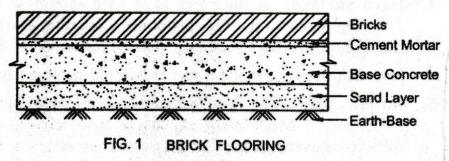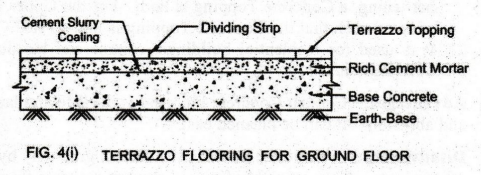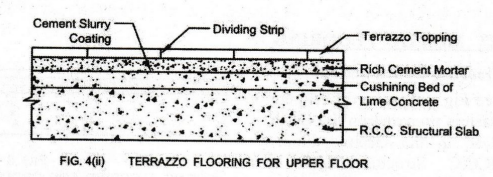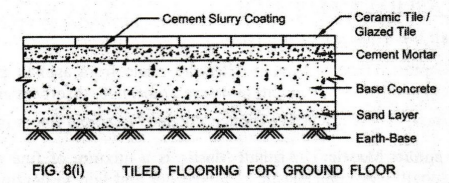Basic Civil & Mechanical Engineering: UNIT III: h. Flooring
Types of flooring
Types of Flooring : 1. Mud Flooring 2. Brick Flooring 3. Stone Flooring 4. Cement Concrete Flooring 5. Terrazzo Flooring 6. Granolithic Flooring 7. Mosaic Flooring 8. Marble Flooring 9. Tiled Flooring 10. Timber Flooring 11. Asphalt Flooring 12. Linoleum Flooring 13. Glass Flooring 14. Rubber Flooring 15. Granite Flooring
TYPES OF FLOORING
1.
Mud Flooring
2.
Brick Flooring
3.
Stone Flooring
4.
Cement Concrete Flooring
5.
Terrazzo Flooring
6.
Granolithic Flooring
7.
Mosaic Flooring
8.
Marble Flooring
9.
Tiled Flooring
10.
Timber Flooring
11.
Asphalt Flooring
12.
Linoleum Flooring
13.
Glass Flooring
14.
Rubber Flooring
15.
Granite Flooring
1. MUD FLOORING
It
is used in villages and for unimportant small buildings. Moist earth is spread
over the prepared bed. It is subjected to ramming. Some chopped straw is also
added before ramming to prevent crack formation.
2. BRICK FLOORING
Flooring
Construction (Fig. 1) After excavating the ground to
the required depth, the earth is rammed well to form an Earth Base. A layer of
Sand is spread above it.

A
Base Concrete course of lean cement concrete of 1:5:10 mix by volume is laid
and cured.
Then,
Cement Mortar 1 : 4 to 1 : 6 mix is spread over the base concrete. Bricks are
la flat or on edge over the cement mortar. A gentle slope of 1 in 40 has to be
provided for th flooring surface for proper drainage.
Pointing
is done using cement mortar for the brick joints. [Pointing means the proces of
raking the joints in brick masonry. The joints are raked to a depth of 10 mm.
These joints are made water-tight using 1 : 1 or 1 : 2 rich cement mortar.] The
flooring is cured for about a week.
Advantages:
It is easy to construct and cheap in initial cost. It is durable, hard and non slippery.
It is easily repairable.
Disadvantage:
It
is water-absorbent.
Uses:
Brick flooring is used where heavy materials are dumped and the floor is
subjected to heavy wear and tear and for rough use.
Examples:
Godowns, Stores and Warehouses
3. STONE FLOORING
Flooring
Construction (Fig. 2)
After
excavating the ground to the required depth, the earth is rammed
well to form an Earth-Base. Above this, a hard Base Concrete is laid.

Cement
Mortar of 1 : 4 mix is spread over the base concrete. Well-dressed Stone Slabs
of square or rectangular shapes are placed on the cement mortar. A gentle slope
of 1 in 40 has to be provided for proper drainage. After the stone slabs are
well set, the mortar is raked out of the joint. The joints are flush pointed
with 1 : 3 cement mortar.
[In
black cotton soil, a layer of sand is used as a cushion below the base
concrete.]
Advantages:
It is economical where stones like Granite, Basalt and Quartzite are available
in plenty. It is hard, durable, easy to construct and maintain. It has good
resistance to wear & tear.
Disadvantage:
It does not give a pleasing appearance. Hence, it is not used in residential
and public buildings.
Uses:
This
type is mostly used for ground floor. It is quite suitable for Heavy duty
industrial floors, Godowns, Loading platforms, Garages, etc.
4. CEMENT CONCRETE FLOORING
Uses
1.
Cement Concrete Flooring is used for Ground Floor and Upper Floors. For Ground
Floor, i concrete flooring is constructed monolithically, i.e., Base Concrete
is laid first and before its hardening, a Concrete Topping is laid. For the
Upper Floors, non-monolithic construction is adopted such that the Concrete
Topping is laid on R.C.C. Structural Slab.
2.
It is used for residential buildings, commercial buildings, schools, hospitals,
small factory buildings, etc.
Advantages:
Cement Concrete Flooring is durable and hard. It has good resistance to wearing
and abrasion. It can be cleaned easily.
Disadvantages:
Concrete flooring is attacked gradually by vegetable oils, fats, acids and
similar other agents. Very smoothly finished cement concrete flooring is
slippery.
1.
Flooring Construction for Ground Floor
See
Fig. 3(i). Ground is levelled, watered and compacted well to form an Earth-Base.

A
cushioning layer of Coarse Sand is spread over the earth-base.
Over
the sand cushion bed, Base Concrete (cement or lime concrete) of 1:4:8 to
1:5:10 lean mix is laid for monolithic construction. It is compacted well. The
top surface of the base concrete is roughly finished. A coat of Cement Slurry
is spread to the rough surface of the base concrete for proper bond between the
base and topping.
The
entire surface is divided into square or rectangular panels. Topping Layer of
Cement Concrete of 1 : 2:4 mix is laid in alternate panels. It is given a
smooth finish using trowel. Curing is done for 15 days. During the curing
period, the flooring should not be used.
2.
Flooring Construction for Upper Floor
See
Fig. 3 (ii). In the case of Upper Floor, Topping Layer of Cement Concrete of 1:
2: 4 mix is laid directly over the already hardened R.C.C. Structural Slab.

The
topping is laid on a coat of pure cement slurry applied over the slab.
Thus,
the topping concrete is bonded to the Structural Slab
5. TERRAZZO FLOORING
Terrazzo
is a special type of Cement Concrete. The concrete consists of White Cement
instead of grey cement, Marble Powder instead of sand and Marble Chips as
coarse aggregate instead of stone aggregates. It can be used for both the
Ground Floor and Upper Floors.
1.
Flooring Construction for Ground Floor
See
Fig. 4(i). It shows terrazzo flooring of Ground Floor.

The
earth is rammed well to form an Earth-Base. The Base Concrete of 1:5 : 10 mix
is laid over the earth-base. The surface of the base concrete is wetted with
water. The concrete base is covered by a thin layer of Cement Slurry.
Over
this, a layer of Rich Cement Mortar of 1 : 3 mix is laid. Metal Dividing Strips
of 20 gauge thickness are inserted into the Cement Mortar layer to form the
desired pattern. The dividing strips are made of plastic, aluminum or glass.
Terrazzo
Topping of about 6 mm thickness is laid over the cement mortar layer. Terrazzo
topping consists of a mixture of cement or coloured cement, marble powder,
chippings of marble and water. Colouring effect is given by adding suitable
pigments to the marble chips. Thus, terrazzo mix is prepared. It is spread to
the required thickness over the cement mortar layer and levelled using trowel.
The
finished terrazzo surface is cured for about 5 days. The surface is ground
using the grinding machine fitted with different grades of carborundum discs to
present a smooth surface. Finally, the surface is washed with soft soap and
dried. The washed floor is then wax polished using polishing machine. The surface
is kept wet while polishing.
2.
Flooring Construction for Upper Floor
See
Fig. 4(ii). It shows terrazzo flooring of Upper Floor. In the case of an upper
floor made of R.C.C. Structural Slab, a Cushioning Bed of lime mortar is laid
over the R.C.C. Slab.

Over
this bed, a coating of of Cement Slurry is given. On this coating, Rich Cement
Mortar is laid. Terrazzo topping is laid in similar manner as explained for
Ground Floor.
Advantages:
Terrazzo flooring gives decorative appearance. It is durable and hard. It can
withstand wear and tear.
Disadvantage:
It is very expensive.
Uses:
Terrazzo flooring is used for residential buildings, commercial buildings,
bathrooms, hotels, hospitals, schools, colleges, theaters, cloak rooms, etc.
6. GRANOLITHIÇ FLOORING
It
is a type of Cement Concrete Flooring with top layer of Granolithic concrete of
stone chips.
Flooring
Construction
See
Fig. 5. The Base Concrete is laid on Earth Base. The Granolithic Concrete mix
is laid on this base concrete for Ground Floor or on R.C.C. Slab for Upper
Floor.

This
mix is made of very hard and fine-grained granite. It is a tough quality
aggregate in rich concrete of 1:1:2 (Cement : Sand : Coarse Granite Aggregate).
It is rammed well and the surface is levelled straight. The straightness of the
level is checked by a Spirit Level.
The
thickness of the granolithic layer varies from 1.25 to 4 cm. It depends upon
the nature of use of the floor. After the surface is hardened, it is kept wet
for about 10 days. Nonslippery floor surfaces can be obtained by sprinkling a
small quantity of Abrasive Grit over the granolithic concrete before drying.
Granolithic
Concrete Floor Topping may be laid monolithically with the Base Concrete for
the ground floor or separately after the base concrete (R.C.C. Structural Slab)
has hardened.
Advantages:
It
is durable, hard and cheap. It does not wear easily and has resistance to
abrasion.
Disadvantage:
For laying granolithic flooring, highly skilled labour is essential.
Uses:
It is used for heavy duty industrial buildings, godowns, garages, etc., to
withstand heavy loads accompanied by severe abrasion. This flooring has all the
uses as that of concrete flooring.
7. MOSAIC FLOORING
Flooring
Construction
See
Fig. 6. A hard Concrete Base is prepared on the Earth Base in the Ground Floor.
[R.C.C. Structural Slab is used for the Upper Floors.]

When
it is wet, a layer of Cement Mortar of 1:2 to 1 : 4 mix is laid. Over this
layer, Mosaic Tiles cut to the desired shapes and sizes are arranged into a
definite outline to get the desired pattern. They are broken into cubes or
wedges and hammered into the mortar at the outline of the pattern.
The
inner area is filled with mosaic pieces. The surface is levelled with a light
stone roller. After allowing to set for 24 hours, the surface is smoothened and
levelled by rubbing with a pumice stone. The floor is used after two weeks of
drying.
Advantage:
Special types of mosaic tiles are available in a variety of patterns and
colors.
Uses:
This type of flooring has wide use in residential and public buildings,
bathrooms, theatres, temples, etc.
8. MARBLE FLOORING
It
is used for Ground Floor and Upper Floors. High quality Marble Slabs in the
required sizes and colours are available in the market. The construction
procedure is the same as that of mosaic flooring, except that marble slabs are
used instead of mosaic tiles.
Flooring
Construction
See
Fig. 7. First, an Earth Base is prepared and a Base Concrete is laid on it in
the case of Ground Floor. [R.C.C. Structural Slab is used as the base for Upper
Floors.]

A
layer of Cement Mortar of 1 : 2 to 1 : 4 mix is spread over the wet base
concrete. The cement mortar is allowed to harden slightly. Over this layer, the
Marble Slabs are laid in position in definite patterns and are levelled. Marble
slabs are square or rectangular in shape.
The
marble slabs should be placed very close to each other so that the joints have
paperlike thickness. It is cured for 7 days before it is put to regular use.
Advantages:
It can be easily maintained. It is attractive in appearance.
Disadvantages:
It
is very costly. It is slippery too.
Uses:
Marble
flooring is used for superior type of floor construction in posh residences in
bathrooms, kitchens, etc.), hospitals, star hotels, temples, churches, mosques,
IT Parks, etc., where extra cleanliness is an essential requirement.
9. TILED FLOORING
It
is used for both Ground Floor and Upper Floors. Tiles made of Ceramic (Clay) or
Cement Concrete or Glazed Tiles, manufactured in different shapes and sizes,
are used.
Flooring
Construction
See Fig. 8(i). In the case of Ground Floor, an Earth-Base is prepared, compacted well and levelled. A layer of sand is spread above it. A layer of Base Concrete is laid over the sand.

A
layer of Cement Mortar is laid over the above. Cement Slurry is coated over the
hardened mortar.
Tiles
are laid flat in position on this bed. The joints should be straight. It should
be very thin. The joints are pointed flush with cement of same colour as the
tiles. The entire surface is polished with different grades of carborundum
stones. The floor is finally wax-polished using polishing machine.
See
Fig. 8(ii). R.C.C. Structural Slab R.C.C. Structural Slab is used as base for
tiled flooring of Upper Floors.

Glazed
Tile: The top surface of the glazed tile is glazed. It is
available in different colours.
Ceramic
Tile (Clay Tile): Ceramic Tiles are vitrified tiles made
from a special clay. They are bonded to the base with a thin coat of cement
mortar.
Advantages:
The floor finish is highly durable. Using coloured cement, attractive and
pleasing patterns and coloured surfaces can be obtained.
Uses:
They are used for posh residences, bathrooms, kitchens, star hotels, IT Parks,
MultiNational Company offices, etc.
10. TIMBER FLOORING
Timber
used for flooring should be well seasoned. It should be free from knots and
other defects. A base course of cement concrete of 75 mm thickness is prepared.
Wooden
fillet strips of size 20 mm × 40 mm are embedded in concrete to a depth of
about 12 mm along the short span. The strips should project above the level of
the base course. On these fillets, the timber flooring planks of 25 mm
thickness are laid.
Timber
flooring should be protected from dampness by providing Damp Proof Course.
Advantages:
It has good aesthetic appearance and warm feeling.
Disadvantage:
Its high cost and limited choice of colours have resulted in reduced use of
wood for flooring.
Uses:
Timber Flooring is used for Balconies in auditoriums, Gallery, Gymnasium, etc.
11. ASPHALT FLOORING
Asphalt
Floorings are of two types:
(i)
Asphalt Tiles: Asphalt Tiles are made from asphalt and
asbestos fibers under pressure. Asphalt tiles are resilient, moisture proof,
non-absorbent and cheaper.
Uses:
These are used to cover wooden / concrete floors in hospitals, offices, etc.
(ii)
Asphalt Mastic: Asphalt Mastic is a mixture of fine
aggregates and natural or artificial asphalt. Asphalt mastic is mixed hot and
laid in continuous sheets or pressed into blocks which can be used as a
flooring.
Concrete
base is used for laying the mixture. Fine sand is sprinkled over the mastic
asphalt surface, when the asphalt is still in plastic stage. Then the surface
is levelled.
Uses:
This is used for Godowns, Railway platforms, Warehouses, Factories, etc.
12. LINOLEUM FLOORING
Linoleum
is produced from linseed oil, pigments, gum and wood or cork flour. Linoleum is
laid on wooden or concrete floors to improve their durability and appearance.
It is available in rolls of various colours and designs. Linoleum Tiles are
also available. It is attractive, economical and easy to wash. But, it does not
offer resistance against dampness and fire.
Uses:
Linoleum flooring is used in Railway coaches, Ships, etc.
13. GLASS FLOORING
Glass
Flooring can be used for special occasions to transmit light from an upper
floor to a lower floor and specially to admit light to the basement from the
ground floor. The structural glass is available in the form of tiles and
blocks. It is fixed in closely-spaced frames so that the glass and the frame
can sustain light loads.
The
structural glass is available in different forms and thicknesses. However,
structural glasses are very costly. They are not commonly used.
14. RUBBER FLOORING
Rubber
Flooring sheets are available in different colours and sizes. These sheets are
made of natural or synthetic rubber. These may be plain, ribbed or grooved
type.
Uses:
It
is used as covering over the concrete floor in residential, public and
industrial buildings including hospitals, transport vehicles like buses, ships,
etc.
15. GRANITE FLOORING
Hard
and tough granite stones cut into slabs and polished have extreme pleasing
appearance. These are available in various textures and colours. Granite Tiles
are also available.
Basic Civil & Mechanical Engineering: UNIT III: h. Flooring : Tag: : - Types of flooring
Related Topics
Related Subjects
Basic Civil and Mechanical Engineering
BE3255 2nd Semester 2021 Regulation | 2nd Semester EEE Dept 2021 Regulation
